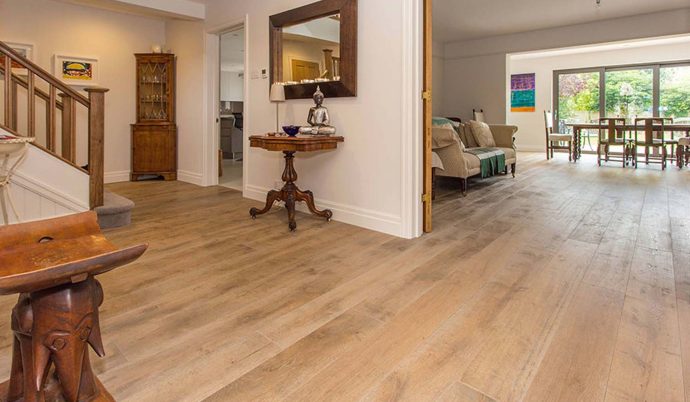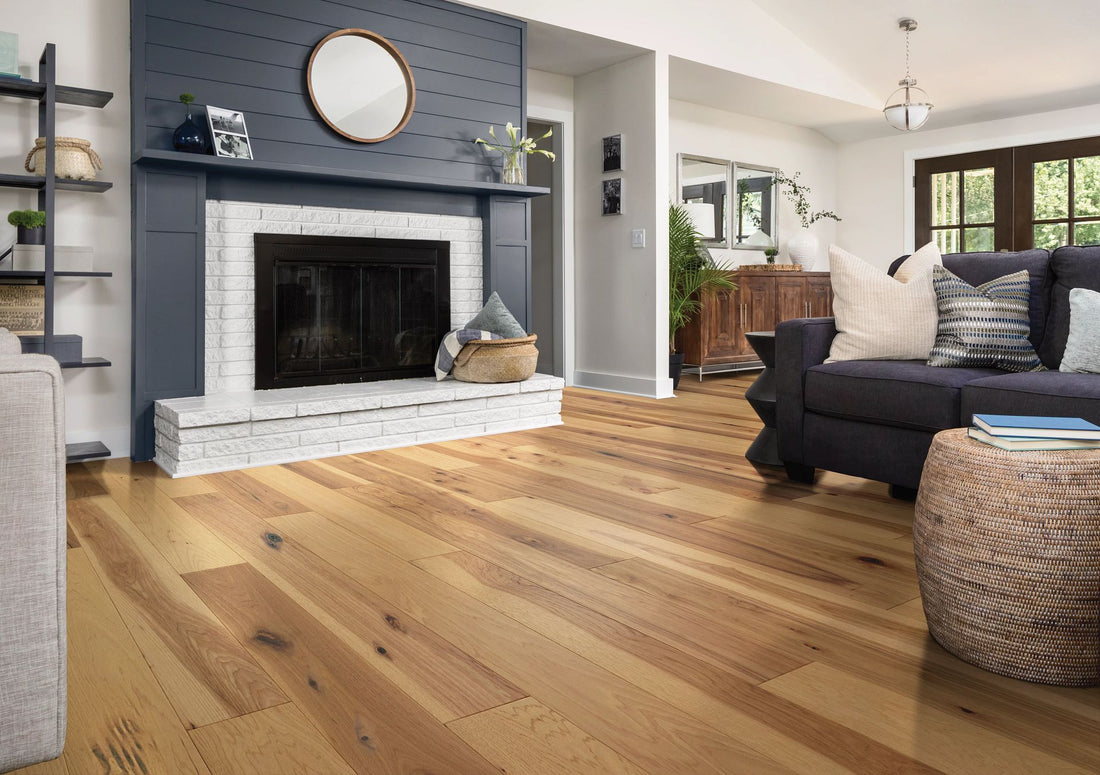Engineered hardwood flooring combines timeless elegance with modern convenience, but its durability and beauty depend on proper care and maintenance. Follow these expert tips and best practices to ensure your engineered hardwood floors retain their allure for years to come.
What Are The Best Practices for Engineered Hardwood Floor Care

Regular Cleaning Routine
Establish a regular cleaning regimen to maintain your floors' luster. Sweep or vacuum with a soft-bristle attachment daily or as needed to remove dirt, dust, and debris, preventing scratches or abrasions that can dull the surface.
Damp Mopping Techniques
Periodically damp mop the floors using a well-wrung, slightly dampened microfiber mop or cloth. Use a manufacturer-recommended hardwood floor cleaner or a mild solution of water and pH-neutral cleaner to remove stubborn stains or grime. Remember, excessive water can damage wood, so ensure your mop is only slightly damp.
Immediate Spill Cleanup
Act promptly to clean spills or messes. Wipe them up immediately with a dry or slightly damp cloth to prevent liquid penetration and potential damage to the wood surface.
Avoid Harsh Cleaners and Abrasives
Steer clear of abrasive cleaning tools, harsh chemicals, or steam mops. These can strip the floor's finish, causing irreversible damage or discolouration.
Furniture Protection
Use felt pads or furniture protectors under the legs of chairs, tables, and heavy furniture to prevent scratches and dents. Lift furniture rather than dragging it across the floor to avoid damage.
Rugs and Mats
Place mats or rugs at entryways and high-traffic areas to minimize tracked-in dirt, grit, and moisture, reducing wear on the floor's surface.
Regular Inspections and Maintenance
Periodically inspect the floors for scratches, dents, or signs of wear. Address any issues promptly by using touch-up kits or contacting professionals for repairs or refinishing as needed.
How Do I Remove Stains Or Spills From Engineered Hardwood Flooring Without Damaging It?

Removing stains or spills from engineered hardwood flooring without causing damage requires prompt action and gentle cleaning methods. Here's a step-by-step guide:
Act quickly: Address spills immediately to prevent them from seeping into the wood. Use a dry or slightly damp cloth to blot the spill gently. Avoid rubbing, as it can spread the stain.
Use a pH-neutral cleaner: For stubborn stains, dampen a soft cloth or mop with a pH-neutral hardwood floor cleaner or a mild detergent mixed with water. Ensure the cloth is well-wrung to prevent excess moisture from reaching the floor.
Spot cleaning: Apply the damp cloth directly to the stained area and gently wipe in a circular motion, working from the outer edges toward the center of the stain. Avoid using excessive water, as it can damage the wood.
Dry thoroughly: After removing the stain, immediately dry the area with a clean, dry cloth to prevent moisture from penetrating the wood.
Consider specialized cleaners: For specific stains like ink, pet stains, or oil-based spills, use specialized hardwood floor cleaners recommended by the flooring manufacturer. Follow the product instructions carefully.
Avoid harsh chemicals or abrasives: Never use abrasive scrubbers, harsh chemicals, ammonia-based cleaners, or steam cleaners, as they can damage the finish or penetrate the wood, causing swelling or discolouration.
Regular maintenance: Prevention is key to minimizing stains. Establish a routine of regular cleaning and timely removal of spills to maintain the floor's pristine condition.
Always test any cleaning solution or method in an inconspicuous area first to ensure it doesn't cause any damage or discolouration to the engineered hardwood flooring. If the stain persists or if you're unsure about the appropriate cleaning method, consider consulting a professional flooring expert for guidance.
What Measures Can I Take To Protect Engineered Hardwood Floors From Furniture Marks Or Dents?

To protect engineered hardwood floors from furniture marks or dents, consider these measures:
Furniture pads or protectors: Attach felt or rubber pads to the legs of chairs, tables, sofas, and heavy furniture to prevent direct contact with the floor. These pads distribute weight more evenly, reducing the risk of indentations.
Lift, don't drag: When moving furniture or heavy items, avoid dragging them across the floor, as this can cause scratches or dents. Instead, lift the furniture and carry it to the desired location. Alternatively, use furniture sliders to glide heavy pieces without scratching the floor.
Rotate furniture: Periodically rotate or move furniture slightly to prevent permanent indentations from forming in specific spots on the flooring due to prolonged weight in one area.
Area rugs or mats: Place rugs or mats in high-traffic areas or beneath furniture to provide an additional layer of protection. These rugs act as a buffer, reducing direct contact between heavy furniture and the floor.
Use wide casters: If furniture has casters or wheels, opt for wider, rubberized casters that distribute weight more evenly and reduce the risk of leaving marks or dents on the floor.
Be cautious during installation: When installing or rearranging furniture, take extra care to avoid dropping heavy objects or tools directly onto the floor, as this can cause immediate damage.
Implementing these preventive measures can significantly reduce the risk of furniture marks or dents on your engineered hardwood floors, preserving their beauty and integrity for years to come.
How Often Should I Clean My Engineered Hardwood Floors?

Cleaning frequency for engineered hardwood floors depends on various factors, including foot traffic, household activities, and environmental conditions. However, here's a general guideline for maintaining the cleanliness of your floors:
Daily or as needed: Sweep or dust mop the floors daily or as required to remove loose dirt, dust, or debris. This helps prevent particles from accumulating and potentially scratching the floor's surface.
Weekly: Perform a more thorough cleaning at least once a week. Use a vacuum cleaner with a soft-bristle attachment or a microfiber mop to remove deeper-seated dirt, pet hair, or smaller particles.
Damp mop periodically: Depending on the level of activity and soil accumulation, damp mop the floors with a well-wrung, slightly dampened microfiber mop or cloth every few weeks or as needed. Use a manufacturer-recommended hardwood floor cleaner or a mild solution of water and pH-neutral cleaner. Ensure the mop is only slightly damp to avoid excess moisture on the floor.
Spill or stain cleanup: Address spills or stains immediately to prevent them from setting into the wood. Blot the spill with a dry or slightly damp cloth and follow up with proper cleaning if necessary.
Seasonal cleaning: Consider a more thorough cleaning regimen, such as using a specialized hardwood floor cleaner or a professional deep cleaning service, on a seasonal basis to maintain the floor's luster and remove any built-up residue or grime.
Adjust the cleaning frequency based on your household's specific needs, but maintaining a consistent cleaning routine will help preserve the beauty and longevity of your engineered hardwood floors.
Final Thoughts On The Best Practices for Engineered Hardwood Floor Care
By adhering to these best practices, you can ensure that your engineered hardwood floors maintain their beauty, durability, and charm for years to come. Remember, a little regular care goes a long way in preserving the timeless elegance of your floors.
Flooring blog articles you may want to read:
Budget-Friendly Elegance: Getting the Look of Hardwood with Laminate Flooring
You Asked, We Answer: Exploring Types of Floor Nosing
You Asked, We Answer: Design Decisions – Floor, Walls, or Furniture?
Vinyl Flooring for Rental Properties: Durable and Budget-Friendly Solutions
